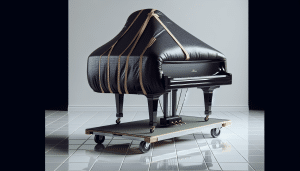Moving a piano feels equal parts heroic and nerve-wracking. You love the music it makes, but the idea of shifting that heavy piece across tight Salt Lake City doorways or down a wintery porch? Yikes. This guide will help homeowners move an Upright Piano without damage — and without losing your cool. It’s practical, conversational, and written for people who’d rather play Chopin than wrestle with furniture straps.
Contents
- 1 Who this is for (and why you should keep reading)
- 2 Why moving an upright piano is trickier than it looks
- 3 Tools and supplies you’ll want on hand
- 4 Quick weight guide (so you don’t guess)
- 5 Step-by-step: How to move your upright piano safely
- 6 Common mistakes and how to avoid them
- 7 When to call the pros (and why it’s not expensive insurance)
- 8 Final practical tips (little things that matter)
- 9 Ready to move your piano without the stress?
Who this is for (and why you should keep reading)
This is for Salt Lake City homeowners who own an upright piano and need to move it—maybe across town, into a new home, or just to a different room. You’ll get a clear checklist, safety pointers, and a step-by-step plan that balances hands-on tips with when to call a pro. You know what? Moving a piano is part DIY, part logistics. This guide helps with the DIY bits and tells you when the job really needs muscle and experience.
Why moving an upright piano is trickier than it looks
On paper, an upright seems straightforward: compact, vertical, done. In reality, pianos are dense, awkward, and unforgiving. They don’t behave like sofas. One wrong tilt and you can damage the action, keys, or finish. Or worse, you can hurt your back. Let me explain: the weight is concentrated low and tight, and the inner mechanics are sensitive to jolts and vibrations.
Also, Salt Lake City homes often have narrow hallways, older staircases, or steep porches. Those local quirks make planning the move more important than brute force.
Tools and supplies you’ll want on hand
Gathering the right gear first saves time and heartbreak. Here’s the short list—trust me, this stuff matters.
Moving essentials:
- Heavy-duty moving blankets: Protects finish and absorbs shocks.
- Piano board or skid board: Distributes weight and stabilizes the instrument.
- Piano dolly (4-wheel): Not the same as an appliance dolly; it’s made for pianos.
- Moving straps (shoulder or harness straps): Helps control and share the load.
- Ratchet straps: Secure piano to the dolly or inside the truck.
- Work gloves, knee pads, and good shoes: Safety first.
Brands and tools you might recognize: Sherpa-style straps, Gator moving blankets, and furniture sliders from Super Sliders. They’re available at hardware stores around the Wasatch Front.
Quick weight guide (so you don’t guess)
| Type | Typical Weight | Notes |
|---|---|---|
| Small upright | 250–400 lbs | Easier to manage on level ground |
| Full-size upright | 400–700 lbs | Requires dolly and multiple helpers |
| Older, heavy uprights | 600+ lbs | Often best for professionals |
Step-by-step: How to move your upright piano safely
Here’s the straightforward sequence. Stick with it. Small steps keep miracles and mishaps in check.
1) Prep the piano and space
Close and lock the keyboard lid. Remove loose items (metronomes, sheet music). Wrap the entire piano in moving blankets, then secure with straps — but don’t compress the legs or pedals too tightly.
Next, clear the path. Measure door widths and ceiling heights. Take pictures of tricky turns. It sounds fussy, but a mismatch at the last minute is a move-ruiner.
2) Positioning and lifting
Place a piano board or skid under the bottom. If you have a piano dolly, slide it carefully beneath. Use at least three able-bodied people for uprights over 350 lbs. One person should lead, giving clear counts: “One—prepare. Two—lift. Three—move.”
Here’s the thing: lifting slowly keeps the internal action safe. Quick jerks transmit shock. Lean into the move; don’t try to yank it upright. Use shoulder straps to shift weight to your hips and legs.
Stairs are where things often go sideways—literally. If you must move on steps, have four to six people: two above, two below, spotters on the sides. Use a ramp if available. If the porch is icy (yes, Utah winter), salt and clear the surface first.
Mild contradiction: you can sometimes tilt a small upright slightly and carry it down a step, but that luxury disappears with heavier uprights. When in doubt, stop and rethink. It’s better to call for help than to create a costly problem.
4) Loading into the truck
Drive slowly with the dolly; use plywood as a ramp if the truck bed is high. Secure the piano with ratchet straps attached to anchor points—aim to prevent forward, backward, and side-to-side movement. Place the piano against a wall, not the middle of the truck; that reduces shifting.
5) Unloading and placement
Reverse the process carefully. Set it down gently. Don’t forget to leave the piano’s internal humidity needs in mind. Salt Lake City has dry summers and cold winters—consider using a humidifier in the room where the piano will live.
Common mistakes and how to avoid them
Underestimating weight: People assume an upright is light because it’s vertical. Wrong. Always check weight ranges.
Skipping protection: A scratched finish is a painful, visible regret. Wrap it well.
Rushing stairs: One hurried step can crack the case or injure someone. Slow down; it’s not a race.
When to call the pros (and why it’s not expensive insurance)
Call professionals if the piano weighs more than 500 pounds, if the move involves multiple flights of stairs, or if you’re dealing with narrow corners and tight doorways. Professional movers bring specialty gear, experience with tricky layouts (like Salt Lake City row homes on the east bench), and insurance that covers what your truck rental won’t.
Honestly, hiring pros often costs less than repairing a broken piano action or refinishing a crushed corner. And it saves your back.
Final practical tips (little things that matter)
Do a dry run: walk the path holding a blanket-wrapped box the size of the piano. Measure twice, move once.
Watch the weather: Utah storms can surprise you. If rain or snow is forecast, reschedule or protect the instrument with plastic over the blankets.
Plan for tuning: Moving can nudge the strings and pins. Book a tuner for a few weeks after the move—your piano will thank you (and so will your ears).
Ready to move your piano without the stress?
If you want help that’s local and experienced, call Utah Piano Movers. We specialize in safe, careful piano moves throughout Salt Lake City and the surrounding Wasatch Front. Whether it’s a quick in-town transfer or a stair-intensive move, we handle the heavy lifting so you don’t have to worry about scratched finishes, strained backs, or broken ivories.
Call us at 801-396-7323 or Request a Free Quote to get started. We’ll walk you through the plan, give a clear, honest estimate, and show up ready—blankets, dolly, straps, and all. No surprises; just a piano where it belongs.



